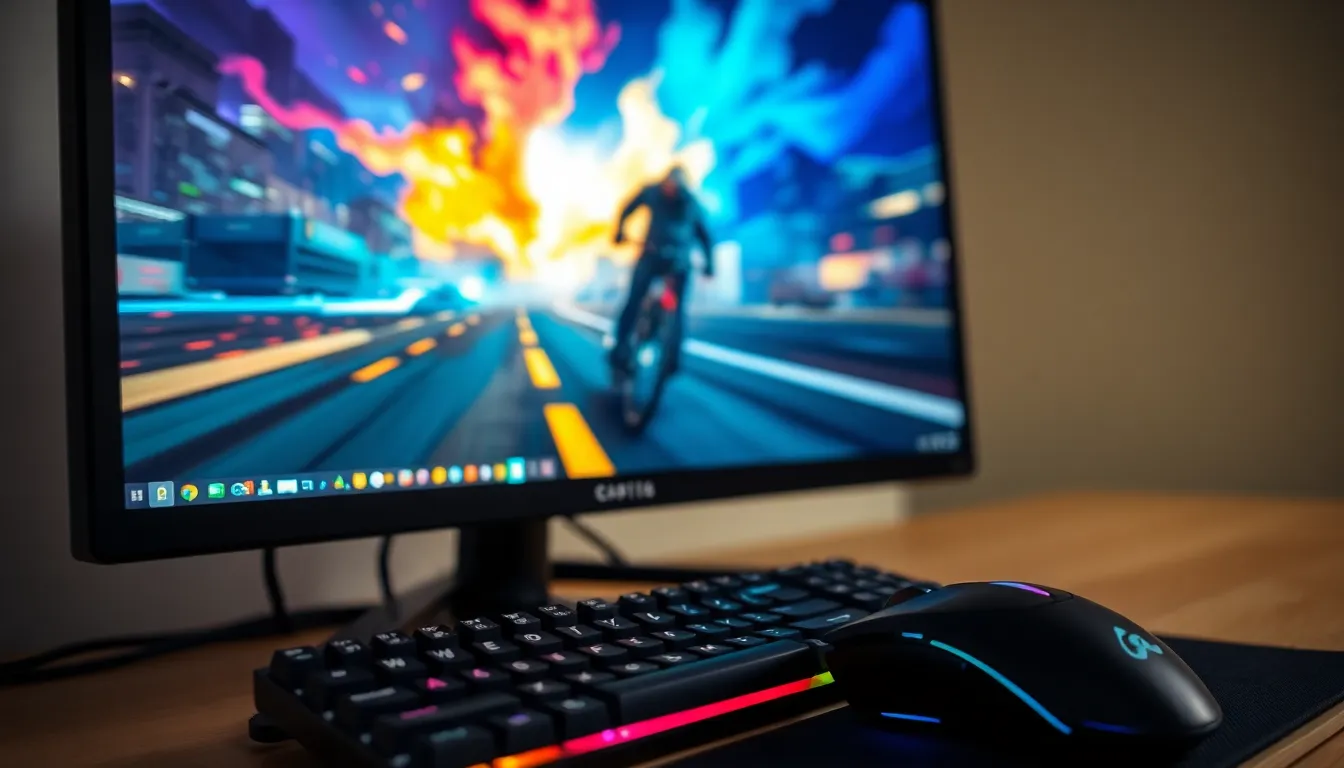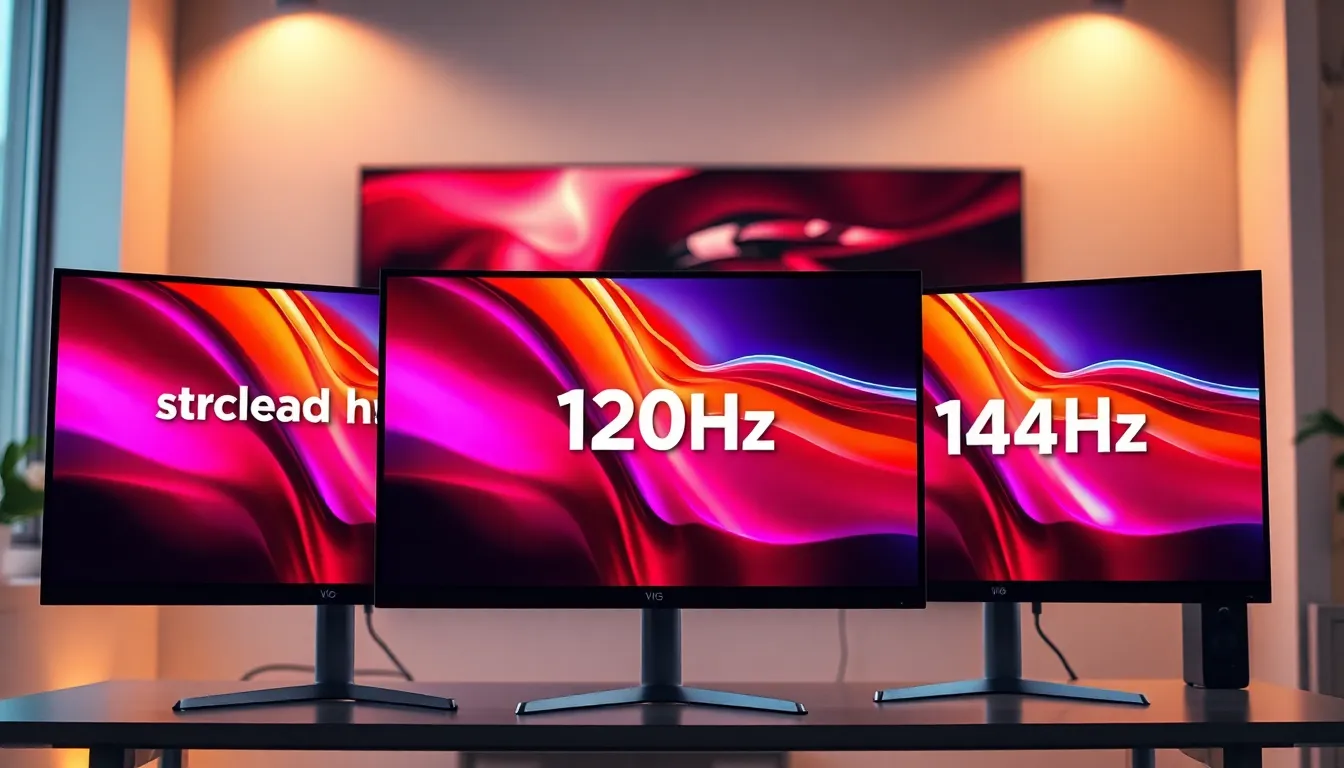In the world of screens, refresh rates are the unsung heroes that can make or break your viewing experience. Imagine trying to watch a thrilling action movie, only to have the images stutter like a nervous toddler on stage. That’s the difference a refresh rate can make. From gaming to binge-watching your favorite series, understanding refresh rates is essential for anyone who wants to enjoy smooth visuals without the hiccups.
Table of Contents
ToggleUnderstanding Refresh Rate Differences
Refresh rate plays a vital role in the overall viewing experience on screens. A clear understanding of refresh rates helps in selecting the right display for specific activities like gaming, movie watching, or professional tasks.
What Is Refresh Rate?
Refresh rate measures how many times per second a display updates its image. Commonly expressed in hertz (Hz), a higher refresh rate indicates smoother motion on the screen. For instance, a 60Hz monitor refreshes the image 60 times per second, while a 144Hz display updates 144 times. This difference significantly influences how smooth and responsive visual content appears, especially during fast-paced scenes.
Importance of Refresh Rate in Displays
Refresh rate impacts user experience significantly across various activities. Gamers prefer higher refresh rates for smoother gameplay and reduced motion blur. Higher rates lead to less stuttering and tearing, enhancing real-time interactions. In contrast, lower refresh rates may suffice for casual browsing or watching videos. Choosing an appropriate refresh rate aligns with intended use, optimizing enjoyment and performance across different display situations.
Types of Refresh Rates


Refresh rates vary significantly, affecting overall visual experience. Understanding these types aids in selecting the right display for specific needs.
Standard Refresh Rates
Standard refresh rates, typically 60Hz, dominate mainstream displays. Many televisions and monitors utilize this rate for casual use. It offers decent performance for browsing the web or watching videos. Graphics transition smoothly at this level, meeting most standard viewing needs. However, gamers may find this rate limiting during high-motion gameplay.
High Refresh Rates
High refresh rates, such as 120Hz and 144Hz, cater to demanding applications. Gamers especially benefit from these rates, experiencing fluid motion and reduced motion blur. Higher refresh rates enhance responsiveness, making fast-paced sequences more enjoyable. Benefits also include smoother navigation in user interfaces. Many gaming monitors provide these options, emphasizing competitive advantages in gameplay. Monitoring advancements in refresh rates ensures optimal performance for various activities.
Impact of Refresh Rate Differences on Gaming
Refresh rates play a crucial role in gaming, affecting both visual smoothness and player performance. Higher refresh rates enhance the gaming experience by delivering smoother animations and improving response times.
Fluidity and Responsiveness
Fluidity and responsiveness directly correlate with refresh rates. A monitor with a 144Hz refresh rate generates significantly smoother visuals compared to a 60Hz display. Gamers benefit from reduced motion blur, allowing for clearer movement during fast-paced scenes. Immediate feedback becomes possible, helping players react swiftly to changing situations. The clarity offered by high refresh rates often results in a more immersive gaming environment. As a result, maintaining a competitive edge during intense gameplay hinges on the choice of display.
Competitive Gaming Advantages
Competitive gaming thrives on the advantages provided by higher refresh rates. Players using 240Hz monitors often experience gameplay that feels more fluid and responsive, which can set them apart during tournaments. Many professional gamers prefer displays with refresh rates above 144Hz to gain a quick response to in-game actions. A higher refresh rate allows for finer control over movements, reducing lag time in critical moments. Increased refresh rates contribute to the overall success in competitive gaming by delivering a tactical advantage in fast-paced environments.
Impact of Refresh Rate Differences on Media Consumption
Refresh rate differences significantly influence the way users experience media. Variations in refresh rates affect how smoothly content plays, especially for dynamic scenes.
Movies and TV Shows
A higher refresh rate enhances the viewing experience for movies and TV shows. Many films and shows are produced at a standard frame rate of 24 frames per second. While a 60Hz display can accommodate this frame rate comfortably, a 120Hz or higher monitor offers smoother motion. For instance, fast action sequences appear clearer, reducing motion blur that distracts viewers. Viewers find higher refresh rates beneficial during fast-paced scenes, where clarity enhances immersion and overall enjoyment. Additionally, even the slowest scenes benefit from improved fluidity, resulting in a more enjoyable visual experience.
Streaming Services
Streaming services cater to a wide variety of content, and refresh rate impacts playback quality. Many platforms offer content optimized for standard refresh rates. However, newer technologies allow viewers to enjoy higher frame rates. For example, some services now offer films at 60 frames per second, and using a 120Hz or 144Hz display maximizes this experience. Streaming high-action sports or gaming content particularly benefits from elevated refresh rates, making motion appear crisper and more engaging. Viewers often report a more interactive experience with high refresh rates, enhancing their overall satisfaction when streaming diverse content.
Understanding refresh rate differences is essential for anyone looking to enhance their visual experience. Higher refresh rates significantly improve motion clarity and responsiveness, especially in gaming and fast-paced media. Choosing the right refresh rate can make a world of difference in how content is perceived and enjoyed.
As technology continues to evolve, staying informed about refresh rates will help users select displays that meet their specific needs. Whether it’s for casual viewing or competitive gaming, investing in a monitor with an appropriate refresh rate can elevate the overall experience, making it smoother and more immersive.








